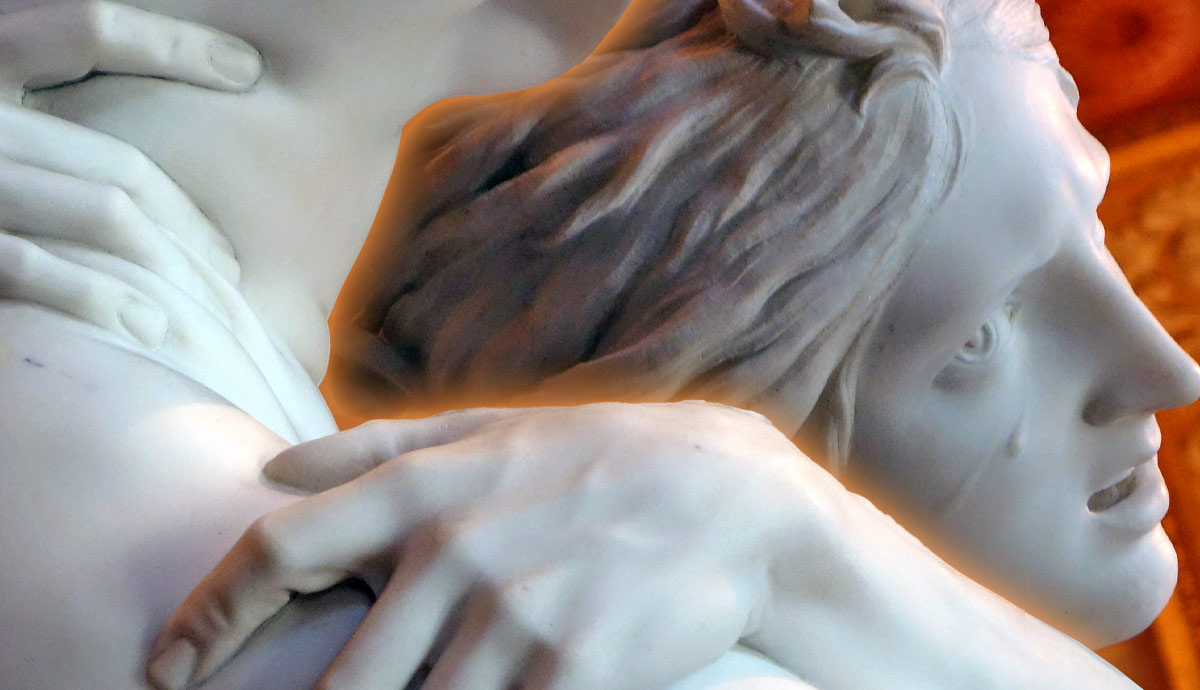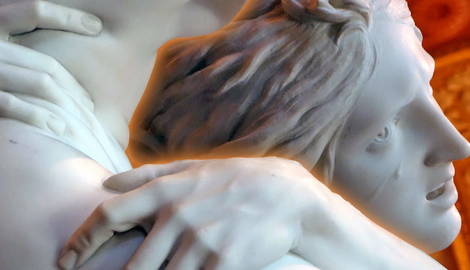
Gian Lorenzo Bernini was an architect, sculptor, and poet whose name became a synonym for the Baroque era. Almost no one in the history of art had that many commissions and patrons. His contemporaries even said that it was impossible not to work for Bernini if you lived in Rome. The early stages of his career were marked with sculptures that showed the metamorphosis of Renaissance and Mannerism into Baroque. Time, space, movement, words, and touch became one.
The Rape of Proserpina by Bernini

It was the eighth year CE and the Roman poet Ovid had just written his Metamorphoses. In one of his verses, he tells a story about Proserpina, the daughter of Ceres and Jupiter, who was abducted by Pluto and taken to the underworld. Proserpina was collecting flowers in the meadow with her friends, nymphs, when Pluto, the ruler of the underworld, abducted her. He cracked the ground from within, flew out with chariots, and took Proserpina to Hades. The years went by and after sixteen centuries, Ovid’s telling of the ancient myth brought it back to life—almost literally.
Gian Lorenzo Bernini was 19 years old when he was noticed by Cardinal Scipione Borghese who was one of the most important patrons of the 17th century. He was also a nephew of Pope Paul V. From 1621 to 1625, Borghese commissioned two sculptural groups from Bernini. These works became known as Borghese sculptures. The Rape of Proserpina was intended to be placed against the wall in the Galleria Borghese so it has a frontal point of view. From that perspective, we can see Pluto, and Proserpina, and also get a glimpse of Cerberus.

Whether you’re looking at this work of art from the front or you’re circling around it, you can’t shake off the feeling that the sculpture does not look still. You can almost feel the wind on your skin—the same wind that’s moving Proserpina’s hair. The mastery of Bernini’s way of treating the famous Carrara marble leads to a theatrical experience where the spectator gets drawn into a scene. One becomes the fourth actor on this Baroque stage.
Pluto’s and Proserpina’s bodies, depending on the focal point, make the form of letters Y or X. Either way, these diagonals emphasize the sense of movement and instability. Although Pluto is a powerful God, Proserpina’s will and fear were so strong that she succeeded in bending his knees while trying to escape his otherwordly embrace. He’s standing with his whole left foot on the ground while the toes on his right foot are barely touching it. Proserpina looks like she’s going to fly away if Pluto loosens his grip a little. You can also see Cerberus, the guardian of the underworld, turning his middle head towards Proserpina’s foot. He represents the fact that they are all already in the land of the dead.
Bernini’s Touch

Bernini came up with the liveliest touch in the history of art—it was made out of stone! The artist played with shadows by creating bulges on the main figures’ bodies. We can see every vein on Pluto’s hands, every twitch of his body, and every bone. The skin of the female figure takes on the contours of Pluto’s fingers. Without knowing about the abduction and the whole story, one could even say that the sculpture seems erotic.
The feelings of eroticism and sensuality come from Bernini’s portrayal of the touch that we can almost feel while looking at it. The last thing that we notice is that the figures are naked. Drapery curls and dances around the figures’ bodies but it barely covers Proseprina’s and Pluto’s private parts. Bernini wanted to show how fast Proserpina was running by making the drapery look like it was flowing. The pointing finger on Pluto’s left hand is modeled to look like he was trying to find the perfect spot on Proseprina’s body in order to rest his palm without hurting her. And yet, he did hurt her.
Showing Emotion

Emotion is one of the main attributes that Bernini brings to his sculptures. We can see the grief and loss in Michelangelo’s Pietà and determination in David, however, we cannot truly feel them. But Bernini’s art makes us feel it all. With his sculptures, the artist incorporated intense emotion into his Baroque style as one of its main principles.
The harmony of the Renaissance was replaced by an explosion of emotions in Baroque. We can see and feel that Proserpina is terrified. If you look close enough you can see two tears running down her left cheek. We can almost hear her calling her mother, Ceres, to save her from the Underworld.
But, Proserpina is already there. The stick we see at Pluto’s feet represents the border between the land of the living and the land of the dead. On the other hand, Pluto looks like he is surprised by Proserpina’s attempts to push him away. She pushes his face with her left palm, moving his left eyebrow as she’s twisting in despair. She knows what her destiny holds for her after this abduction and she sheds bitter tears, while Pluto is seen smiling.
Bernini’s Apollo and Daphne

In another Borghese piece made by Bernini, we see Apollo and Daphne. Apollo, the god of the Sun, provoked Cupid, the god of love and desire, which eventually led to Cupid’s revenge. He hit Apollo with a golden arrow that made him madly in love with Daphne, a nymph associated with springs and streams. Then, he struck Daphne with a silver arrow which made her feel completely disgusted with Apollo. As she vowed to keep her virginity, she begged her father, the river god Peneus, to take away her beauty which was the cause of all her troubles. Peneus heard her and turned her into a laurel tree. Ovid wrote about the myth and we can see the story fully come to life when looking at Bernini’s work.

Back in the 18th century German writer and art critic Gotthold Ephraim Lessing made a clear distinction between poetry and art. He claimed that poetry had the ability to tell the whole story, while art could show just a single moment caught in time. With this sculptural group, Bernini challenged this claim.
Looking at the work, especially its left side, spectators can see the whole myth come alive. Apollo’s arm around Daphne’s body looks like it’s in slow motion. We can feel the movement led by his unbearable desire to touch her. Once again, Bernini masterfully presented the drapery and the movement of the wind showing Daphne’s hair turning into leaves. Her hands are shown in the moment when they turn into branches. The laurel tree is seen growing between her and Apollo. Using disproportions and bold diagonals, Bernini made a fusion of space and time, creating a moment stretched to its limits. When looking at this work of art we can understand and feel the whole myth despite the fact that we’re only observing a carved piece of stone. That’s Baroque.

If Pluto’s touch is the most vivid one in art history, Apollo’s must certainly be the saddest. As soon as he catches Daphne her skin starts turning into a tree. Daphne is portrayed while turning her head to be sure that Apollo cannot come closer to her. At the same time, she looks scared and alert. Apollo can still feel her pulse under the rough bark and we know that he’ll continue loving his metamorphosed darling with the same intensity. We see him place his hand on Daphne’s stomach with no intention of ever letting go.








